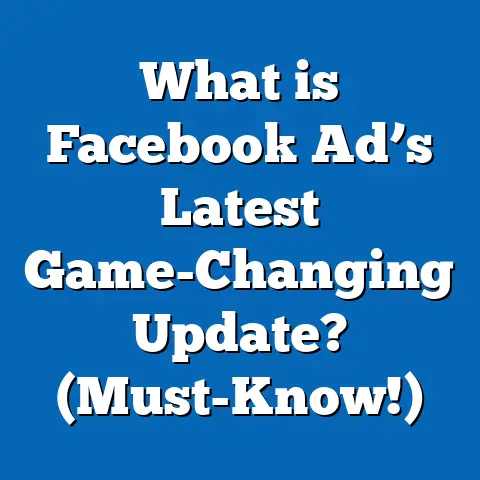What is ATC in Facebook Ads? (Unlocking Conversion Secrets)
Introduction: Remembering the Early Days of Online Shopping
Remember when online shopping first started gaining traction? The experience was often slow, uncertain, and full of guesswork. You’d browse through a handful of products, unsure if your order would arrive on time or if the checkout process would be straightforward. Fast forward to today, and digital advertising has completely transformed how brands connect with consumers. Facebook Ads, as one of the most powerful platforms, allow businesses to reach millions of potential customers with laser precision.
But in this sea of data and metrics, one that stands out for driving real sales is ATC — short for Add to Cart. This seemingly simple action carries enormous weight in understanding customer intent and optimizing your marketing strategy. Think of ATC as the digital equivalent of a shopper picking up an item and placing it in their cart at a physical store — it’s a strong sign they are seriously considering buying.
What is ATC in Facebook Ads?
Definition of ATC (Add to Cart)
Add to Cart (ATC) is a specific event tracked by Facebook’s advertising platform that records when a user adds a product to their shopping cart on an e-commerce website or app. This action indicates a higher level of interest than simply viewing a product page — the user has taken a concrete step toward making a purchase.
The ATC event is part of Facebook’s standard set of tracked events that advertisers use to measure user behavior and optimize campaigns effectively.
Why ATC is a Game-Changer for Advertisers
- Signals Strong Purchase Intent: Unlike superficial engagement metrics such as page views or clicks, ATC demonstrates that the user is actively considering buying. This makes it a more reliable indicator of potential conversions.
- Enables Smarter Audience Targeting: By tracking who adds items to their cart, advertisers can create custom audiences for retargeting campaigns. These audiences are highly valuable because they have shown explicit interest but have not yet converted.
- Improves Campaign Optimization: Facebook’s machine learning can optimize ad delivery toward users likely to add products to their cart when you configure your campaigns with ATC as the conversion objective.
- Bridges Awareness and Purchase: ATC sits in the middle of the customer journey — far beyond awareness but just before purchase — providing critical insights into user behavior.
How ATC Fits Into the Conversion Funnel
Understanding where ATC fits in the funnel can help marketers design campaigns that guide users from curiosity to action:
| Funnel Stage | User Action | Typical Facebook Event |
|---|---|---|
| Awareness | User discovers product | View Content |
| Interest | User explores product details | View Content |
| Consideration | User adds product to cart | Add to Cart (ATC) |
| Intent | User starts checkout process | Initiate Checkout |
| Purchase | User completes purchase | Purchase |
ATC serves as a critical middle funnel touchpoint that helps marketers identify prospects ripe for conversion-focused messaging.
How Facebook Tracks Add to Cart Events
Facebook Pixel: The Backbone of Event Tracking
The Facebook Pixel is a snippet of JavaScript code advertisers place on their websites. It tracks user actions such as page views, clicks, and specifically Add to Cart events by firing the relevant pixel event when users interact with product pages.
For example, when a visitor clicks the “Add to Cart” button on your website, the pixel records an AddToCart event along with details like the product ID, price, and currency.
Facebook SDK for Mobile Apps
For businesses with mobile apps, Facebook provides an SDK (Software Development Kit) that tracks similar events within apps. This allows advertisers to capture ATC actions even when users add products from their phones or tablets.
Event Parameters & Customization
Facebook lets advertisers customize event tracking by attaching parameters that provide richer data:
- content_ids: The unique ID(s) of the product(s) added.
- content_name: Name or title of the product.
- content_type: Product category or type.
- value: Monetary value of the product added.
- currency: Currency code (e.g., USD).
Adding these parameters improves the granularity of your data and allows better reporting, targeting, and optimization.
Event Deduplication
If you track events via multiple sources (pixel + SDK), Facebook requires event deduplication setup to prevent double counting. This ensures your ATC data is accurate and reliable for decision-making.
Deep Dive: Understanding ATC Metrics & Performance Data
Average Add to Cart Rates Across Industries
Add to Cart rates vary widely depending on industry, device type, seasonality, and other factors. Here are some benchmark figures from recent studies:
| Industry | Average Add to Cart Rate (%) |
|---|---|
| Fashion & Apparel | 8 – 12% |
| Electronics | 6 – 10% |
| Beauty & Personal Care | 10 – 15% |
| Home & Garden | 7 – 11% |
| Health & Wellness | 9 – 13% |
(Source: Shopify Analytics 2024)
Mobile devices typically have lower ATC rates (6-8%) compared to desktop (10-14%), reflecting differences in user behavior and ease of adding items on smaller screens.
Add to Cart vs. Purchase Rate
Not all Add to Cart events convert into completed purchases. Industry averages suggest:
- Approximately 30-40% of users who add items to their cart complete checkout.
- Cart abandonment rates remain stubbornly high, averaging around 69.57% globally (Statista 2024).
This gap underscores the critical importance of retargeting strategies that focus on users who added items but didn’t finalize the purchase.
Cost Per Add to Cart (CPATC)
When running ads optimized for ATC, cost per add to cart becomes an essential metric. Lower CPATC means you’re acquiring high-intent potential buyers more efficiently.
According to data from Wordstream:
- Average CPATC ranges from $2 to $10 depending on industry and campaign quality.
- E-commerce brands with optimized campaigns often achieve CPATCs below $5.
Case Study: How Optimizing for ATC Boosted Revenue by 62%
Background
A mid-sized apparel retailer wanted to reduce their cost per acquisition and increase overall sales volume using Facebook Ads. They had been mainly optimizing for purchases but noticed high costs and low volume.
Strategy
- Launched parallel campaigns: one optimized for Purchase events, another optimized for Add to Cart events.
- Used custom audiences based on ATC data for dynamic retargeting ads.
- Applied value-based lookalike audiences derived from highest-value ATC users.
- Leveraged automated rules to scale budgets on best-performing ad sets focused on ATC.
Results After Three Months
| Metric | Before Optimization | After Optimization |
|---|---|---|
| Cost per Add to Cart (CPATC) | $7.50 | $3.90 |
| Add to Cart Rate | 9% | 15% |
| Purchase Conversion Rate | 32% | 38% |
| Return on Ad Spend (ROAS) | 2.1x | 3.4x |
| Total Revenue | $150,000 | $243,000 |
Key Takeaways
Optimizing for ATC lowered acquisition costs while increasing both add-to-cart actions and final purchases. Using ATC data for retargeting created more personalized ad experiences, lifting conversion rates and revenue significantly.
Practical Guide: How to Set Up and Optimize Add to Cart Tracking in Facebook Ads
Step 1: Install Facebook Pixel Correctly
- Add the Facebook Pixel code to your website header.
- Verify installation using Facebook’s Pixel Helper tool.
- Ensure the
AddToCartevent fires correctly when users click “Add to Cart” buttons.
Step 2: Customize Event Parameters
Include detailed information such as product IDs, values, and currency for better segmentation and reporting.
fbq('track', 'AddToCart', {
content_ids: ['12345'],
content_type: 'product',
value: 29.99,
currency: 'USD'
});
Step 3: Create Custom Audiences Based on ATC
Within Facebook Ads Manager:
- Navigate to Audiences > Create Audience > Custom Audience.
- Select “Website Traffic” as source.
- Choose “AddToCart” event within your pixel.
- Define a retention window (e.g., last 30 days).
- Name and save the audience for retargeting campaigns.
Step 4: Launch Campaigns Optimized for ATC
When creating new campaigns:
- Choose “Conversions” as the campaign objective.
- Select “AddToCart” as the conversion event.
- Set an appropriate budget based on historical data.
- Monitor CPATC closely during campaign runtime.
Step 5: Retarget Users Who Added to Cart But Didn’t Purchase
Create retargeting ads with:
- Dynamic product ads showing exact items added.
- Incentives like discounts or free shipping.
- Urgency messaging (“Limited stock left”).
Advanced Techniques for Leveraging ATC Data in Facebook Advertising
Use Value-Based Custom Audiences
Not all add-to-cart actions have equal value. Weight your custom audiences by purchase potential using order value data collected via pixel parameters. This allows you to prioritize high-value prospects in lookalike audiences or retargeting campaigns.
Employ Event Deduplication and Server-Side Tracking
With evolving privacy regulations like iOS14+ ATT policies impacting pixel accuracy:
- Use server-side tracking via Facebook’s Conversions API alongside pixel tracking.
- Set up event deduplication so actions aren’t double counted.
- This approach ensures more reliable ATC data feeding into Facebook’s algorithms.
Automate Campaign Management Based on ATC Metrics
Facebook Ads Manager allows setting automated rules:
- Pause ad sets if CPATC exceeds your cost threshold.
- Increase budget or bid if add-to-cart volume reaches target levels with good ROAS.
Automation reduces manual monitoring and improves campaign efficiency.
Experiment with Different Ad Formats Targeting ATC Audiences
Consider using:
- Carousel ads showcasing multiple products added or related items.
- Collection ads for immersive shopping experiences.
- Video ads demonstrating product benefits targeted at users who have added those items.
Comparing Add to Cart (ATC) with Other Key Facebook Events
Understanding how ATC compares with other conversion events helps marketers craft more effective funnels:
| Event | Definition | Typical Funnel Stage | Primary Use Case | Relative Volume & Intent |
|---|---|---|---|---|
| View Content | User views product page | Awareness/Interest | Broad interest measurement | High volume; lower purchase intent |
| Add to Cart (ATC) | User adds item(s) to shopping cart | Consideration | Mid-funnel engagement & intent | Medium volume; stronger purchase signal |
| Initiate Checkout | User begins checkout process | Intent | Closer to purchase | Lower volume; higher purchase intent |
| Purchase | User completes transaction | Conversion | Final sales measurement | Lowest volume; highest intent |
Why Optimize For ATC?
While direct purchase optimization targets bottom-of-funnel users, optimizing for ATC helps scale mid-funnel engagement at often lower costs. It captures users who are highly motivated but may need additional nudging before buying.
Industry Comparisons: Facebook’s ATC vs Google Ads & Other Platforms
Facebook Ads vs Google Ads Add-to-Cart Tracking
| Feature | Facebook Ads | Google Ads |
|---|---|---|
| Tracking Method | Facebook Pixel / SDK + Conversions API | Google Tag Manager / Global Site Tag |
| Optimization Options | Optimize for AddToCart event | Optimize for Add-to-Cart conversion action |
| Audience Creation | Custom & Lookalike Audiences based on ATC | Remarketing Lists based on cart additions |
| Retargeting Capabilities | Dynamic Product Ads retargeting | Dynamic Remarketing Ads |
| AI & Machine Learning | Advanced algorithm targeting mid-funnel events like ATC | Smart Bidding strategies targeting conversions |
Facebook’s strength lies in its detailed audience segmentation and social graph data that help identify users similar to those who add items to carts. Google focuses more on intent via search queries combined with site behavior data.
Other Platforms (Pinterest, TikTok)
Pinterest and TikTok also allow tracking Add-to-Cart events but generally have smaller ecosystems compared to Facebook in terms of retargeting sophistication and audience size. However, TikTok’s rapid growth means emerging capabilities should be watched closely.
Impact of Privacy Changes on Tracking Add To Cart Events
Apple’s iOS14+ update introduced App Tracking Transparency (ATT), requiring explicit user permission before tracking across apps and websites. This has caused significant challenges:
- Reduced visibility into user actions like add-to-cart.
- Increased reliance on aggregated data via Facebook’s Aggregated Event Measurement (AEM).
Marketers should adapt by:
- Prioritizing first-party data collection (email lists, CRM integration).
- Using server-side tracking via Facebook Conversions API.
- Setting up multiple prioritized events in AEM focusing on key actions like AddToCart.
Facebook continues enhancing AI models to compensate for less granular data while maintaining campaign performance.
Measuring Success: Key Metrics Related to Add To Cart Events
Track these metrics regularly for a full picture of your ATC campaign performance:
- Add To Cart Rate: Percentage of visitors adding products relative to total site visitors or ad clicks.
- Cost Per Add To Cart (CPATC): Amount spent on ads divided by number of add-to-cart actions.
- Add To Cart Conversion Rate: Percentage of those who added items who proceed to purchase.
- Return On Ad Spend (ROAS): Revenue generated relative to ad spend from campaigns optimized for or targeting ATC audiences.
- Cart Abandonment Rate: Percentage of carts created but not converted into sales.
- Frequency & Reach: How often your ads reach potential customers who already added products.
Using Add To Cart Data Beyond Advertising
ATC data can also fuel other business functions:
- Inventory Management: Track which products get frequent add-to-cart actions but low purchases — signals possible pricing or usability issues.
- Product Development: Identify trends in customer preferences through popular add-to-cart items.
- Email Marketing: Integrate with CRM systems to send cart abandonment emails personalized with added products.
- Customer Support: Follow-up with customers who added items but didn’t buy can improve satisfaction and conversion chances.
FAQs About Add To Cart in Facebook Ads
Q1: Can I Optimize My Campaign Directly For Purchases Instead of Add To Cart?
Yes, but optimizing for purchases often requires more data volume and can be more expensive per conversion. Optimizing for ATC allows you to warm up potential buyers earlier in the funnel at a lower cost.
Q2: How Long Should I Retarget Users After They Add To Cart?
A typical retargeting window is between 7–30 days depending on your sales cycle length. Shorter windows work well for impulse buys; longer ones suit higher-consideration products.
Q3: What If I Don’t See Any Add To Cart Events in My Pixel Data?
Check pixel installation thoroughly using tools like Facebook Pixel Helper. Ensure the event fires correctly when clicking “Add To Cart.” Also verify no ad blockers or privacy settings prevent tracking.
Q4: Is It Better To Use Automatic or Manual Placements When Optimizing for Add To Cart?
Automatic placements generally allow Facebook’s algorithm more flexibility to find the best performing placements, which can improve CPATC outcomes.
Summary & Key Takeaways
- Add To Cart (ATC) is a crucial mid-funnel event signaling strong purchase intent.
- Proper setup using Facebook Pixel/SDK with detailed parameters ensures accurate tracking.
- Benchmark your ATC rate against industry standards (8–12%) and optimize accordingly.
- Campaigns optimized for ATC often deliver lower acquisition costs compared to direct purchase optimization.
- Retargeting users who added items but didn’t buy provides high ROI opportunities.
- Leverage value-based audiences, automated rules, and server-side tracking for advanced optimization.
- Stay updated on privacy changes impacting tracking accuracy and adapt strategies accordingly.
Mastering ATC in your Facebook Ads strategy unlocks deeper insights into user behavior and paves the way for increased conversions and sustainable revenue growth.
Next Steps for Marketers & Business Owners
- Audit Your Current Pixel Setup – Ensure Add To Cart events are firing accurately across devices.
- Segment Your Audiences – Build custom audiences based on recent add-to-cart actions.
- Launch Dedicated Campaigns – Test optimizing ads specifically for Add To Cart conversions.
- Retarget Effectively – Use dynamic product ads with incentives targeting non-purchasing add-to-cart users.
- Monitor CPATC Closely – Adjust bids and budgets based on cost efficiency metrics related to add-to-cart actions.
- Explore Advanced Tactics – Incorporate server-side tracking, automated rules, value-based lookalikes.
- Keep Learning – Follow platform updates related to privacy, AI enhancements, and new ad formats supporting e-commerce growth.
With this deep understanding of what ATC means within Facebook Ads — how it works, why it matters, and how you can harness it — you’re now equipped to unlock conversion secrets that drive real business results.
If you want me to include specific templates or detailed setup guides with screenshots next, just let me know!






